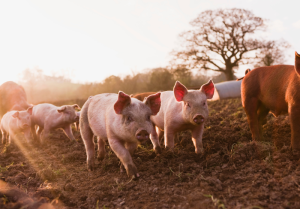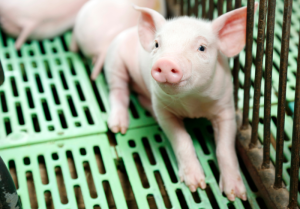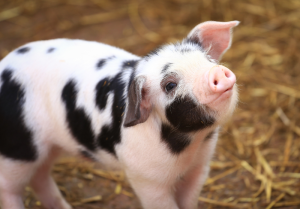What A Baby Pig Is Called
There is nothing quite so cute and endearing as a baby pig. With heads and ears that seem too big for their bodies, and bright, curious eyes, it’s no wonder we are fascinated with these tiny creatures. Do you know what a baby pig is called?
What is a baby pig called? A baby pig is called a piglet. Piglets are intelligent, curious, and friendly. Coupled with their large ears and stubby tails, it is easy to see why they have charmed their way into many of our hearts – not to mention our movie screens. Not only are piglets cute, but they are fascinating animals to learn about.
Below you will find over 50 fun facts about piglets.
Baby Pig Facts: Gestation and Pregnancy
- The average gestation period of a sow is 3 months + 3 weeks + 3 days. How easy is that to remember?
- Sows farrow an average of 8-13 piglets in a single litter. Some breeds will produce even more, however, with the Meishan pig regularly producing up to 20 piglets per litter.
- The record for the number of piglets in a litter would fall to an Australian sow who farrowed 37 piglets at once. All but one were born alive, and ultimately 33 of them survived.
- A sow can farrow two litters of piglets per year, meaning that each year a single sow can produce up to 30 piglets!
- Sows can conceive multiple times in a single estrus, so if you see piglets that are significantly smaller, it may be because they are actually younger than their littermates!
Baby Pig Facts: Birth and Beyond 
- Piglets are able to get up on all four feet shortly after birth, and you can usually find the first ones of the litter nursing happily while the sow is farrowing the rest of its siblings.
- The average piglet will weigh around 2.5 pounds at birth and will gain an average of 30 pounds in its first 8 weeks of life.
- The largest piglet ever farrowed on record weighed 5 pounds, 4 ounces. Sadly, the piglet was stillborn.
- Piglets are born one at a time but in quick succession of one another. If your sow is getting ready to farrow, you can often miss it by stepping away for only a short period of time.
- If you are around for the birth, you may find an occasional piglet born with the amniotic sac intact. Once you remove the sac, the piglet may need to be swung gently by the hind legs to encourage fluid drainage from the lungs.
- Because piglets are born with very little hair, they are especially susceptible to chilling and may benefit from a heat lamp (kept far enough away from the “nest” so as not to be a fire hazard).
- Studies have indicated that if a heat lamp is placed near the rear of the sow, this can help increase piglet mortality. This is thought to be because the piglet is receiving additional warmth before even exiting the birth canal.
- Studies have shown that human presence during farrowing can increase the survival rate in a litter. This is likely due to the early intervention a caretaker can provide to a disadvantaged piglet.
- Piglets are born with only enough fat to last them for one day, so it’s important they start nursing as soon as possible after birth!
Baby Pig Facts: Health, Biology, and Physical Needs
- Piglets get all of the nutrition they need from the sow, except iron. Fortunately, they can usually get all of the iron they need simply by rooting around in the dirt.
- Piglets are born with razor-sharp teeth that many farmers clip in the first couple of days of life to protect the sow’s teats.
- Pigs are fast-growing animals, and piglets are ready to wean in as little as one month’s time.
- Piglets are omnivores, but there is one item on a carcass that piglets cannot digest, and that is teeth!
- Piglets may appear to be tip-toeing around the yard. This is because they usually only walk on their two toes.
- Because of their light skin and scarce amount of hair, piglets of the traditional white breeds sunburn easily and must have ready access to shade.
- Piglets do not sweat; instead, they use their environment (i.e. mud) to keep cool.
- Piglet hearts are so similar to human hearts that surgeons will use heart valves from piglets to replace damaged human heart valves.
- Piglet skin is also used as grafts for human burn victims.
- Piglet organs are so integral to human medical advances that scientists are working to create a pig hybrid with organs that will even more closely resemble a human’s for transplants.
- Some piglets have erect ears, while some have floppy ears. Pig breeds that end in “-shire” have erect ears.
- There are 24 diseases that can be transmitted from piglets to humans.
- Because of the harmful bacteria that piglets can carry, many are given antibiotics at birth. This is why it can be difficult in some areas to find “antibiotic-free” pork.
- Approximately 9.4% of piglets do not survive between birth and weaning. Most of these deaths were the result of suffocation, so make sure the sow’s farrowing quarters are sufficient enough in size, so there is plenty of room for everyone.
Baby Pig Facts: Intelligence
- Piglets recognize themselves if looking in a mirror, which is a sign of intelligence that even dogs do not meet.
- Piglets can learn tricks easily and have been known to learn their names by 2 weeks of age.
- Piglets love to play – even with humans! You can play with a piglet in much the same way as you would play with a puppy. Playfulness is another sign of intelligence.
Baby Pig Facts: Social Interaction and Behavior 
- Piglets love to sleep in piles, and you will often find them sleeping nose-to-nose.
- Piglets grunt and squeal to communicate with one another (and you), and over 20 different vocalization patterns have been identified within pig herds.
- Sows grunt softly to their babies while the piglets are nursing and have even been known to “sing” to them.
- Piglets have their own preferred teat that they will seek out each time they nurse from their mother.
- Despite their reputation, piglets are actually very clean animals and will avoid soiling the area where they sleep if possible.
- Piglets hate being picked up and have an innate fear of being handled. When on the ground, however, they are quite friendly.
- A piglet’s squeal can be heard far away and can reach up to 115 decibels.
- One of the things that piglets love to play with is a ball. It is not uncommon to see a herd of piglets chasing after a ball in a pasture.
- Daddy time isn’t always possible for piglets, as most boars are simply too aggressive and can easily harm their young.
- Sows are very protective of their piglets, and many farmers have to use a “pig board” or other barrier in order to get close enough to the piglets to do a quick health check.
- Like dogs, piglets love belly rubs!
- Wild sows will take in and care for orphaned and disadvantaged piglets. If encouraged through human intervention, domestic sows will do the same.
- If one or two piglets need to be nursed by a “foster” sow, it is best to move the males over. Females nursed by sows other than their mothers tend to suffer reproductively.
Baby Pig Facts: Superior Senses
- A piglet’s sense of smell is 2,000 times better than a human’s sense of smell.
- Because of their incredible sense of smell, pigs have been used by the police to sniff out drugs and by the military to sniff out land mines.
- There is nothing a piglet loves more than a tasty treat – piglets have approximately 15,000 taste buds. In comparison, humans have around 9,000 taste buds.
Other Fun Facts About Baby Pigs
- Piglets are resilient and adaptive and can thrive on every continent but Antarctica.
- Because they are so adaptive, piglets can be highly destructive when feral and are even considered pests in some areas!
- Piglets are distantly related to hippos! You can kind of see it, can’t you?
- Aside from meat, piglets are also used in the pharmaceutical and medical industries. There are over 40 pharmaceuticals that use pig products.
- Piglets are a hot commodity – there are currently around 800 million domestic pigs worldwide (with over half of them residing in China).
The Popularity Of Baby Pigs
It is easy enough to see why videos and images of piglets are so popular – piglets are not only arguably one of the cutest baby animals on the planet, but there are so many interesting aspects to their growth, behavior, and history. Pigs have always fascinated humans, and likely always will, with more and more research involving pigs every year.
So what do you think – are you ready to raise a litter of piglets? You can learn about owning and raising pigs in my articles below, or find my most recent articles here!

